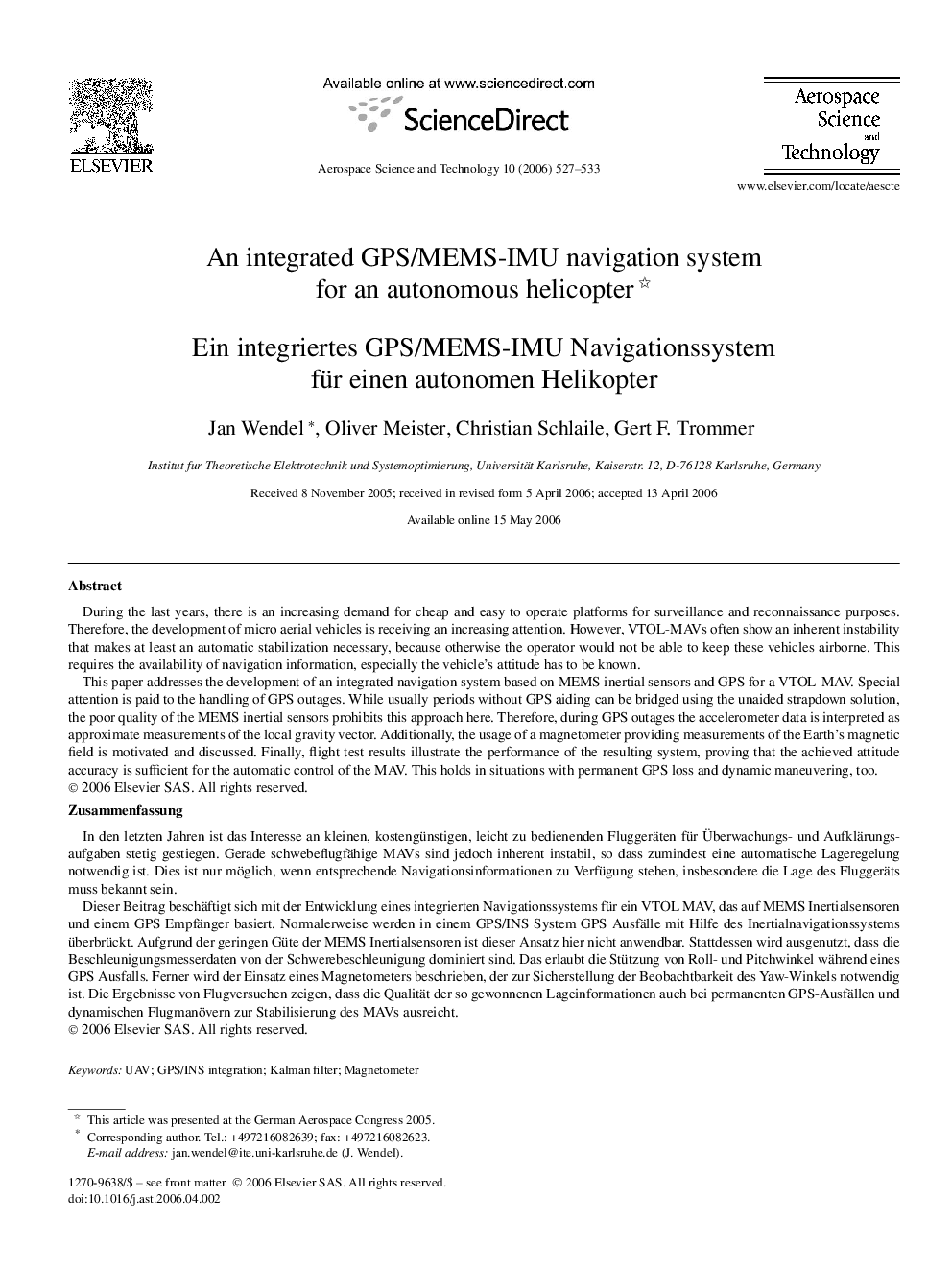| Article ID | Journal | Published Year | Pages | File Type |
|---|---|---|---|---|
| 1719009 | Aerospace Science and Technology | 2006 | 7 Pages |
During the last years, there is an increasing demand for cheap and easy to operate platforms for surveillance and reconnaissance purposes. Therefore, the development of micro aerial vehicles is receiving an increasing attention. However, VTOL-MAVs often show an inherent instability that makes at least an automatic stabilization necessary, because otherwise the operator would not be able to keep these vehicles airborne. This requires the availability of navigation information, especially the vehicle's attitude has to be known.This paper addresses the development of an integrated navigation system based on MEMS inertial sensors and GPS for a VTOL-MAV. Special attention is paid to the handling of GPS outages. While usually periods without GPS aiding can be bridged using the unaided strapdown solution, the poor quality of the MEMS inertial sensors prohibits this approach here. Therefore, during GPS outages the accelerometer data is interpreted as approximate measurements of the local gravity vector. Additionally, the usage of a magnetometer providing measurements of the Earth's magnetic field is motivated and discussed. Finally, flight test results illustrate the performance of the resulting system, proving that the achieved attitude accuracy is sufficient for the automatic control of the MAV. This holds in situations with permanent GPS loss and dynamic maneuvering, too.
ZusammenfassungIn den letzten Jahren ist das Interesse an kleinen, kostengünstigen, leicht zu bedienenden Fluggeräten für Überwachungs- und Aufklärungsaufgaben stetig gestiegen. Gerade schwebeflugfähige MAVs sind jedoch inherent instabil, so dass zumindest eine automatische Lageregelung notwendig ist. Dies ist nur möglich, wenn entsprechende Navigationsinformationen zu Verfügung stehen, insbesondere die Lage des Fluggeräts muss bekannt sein.Dieser Beitrag beschäftigt sich mit der Entwicklung eines integrierten Navigationssystems für ein VTOL MAV, das auf MEMS Inertialsensoren und einem GPS Empfänger basiert. Normalerweise werden in einem GPS/INS System GPS Ausfälle mit Hilfe des Inertialnavigationssystems überbrückt. Aufgrund der geringen Güte der MEMS Inertialsensoren ist dieser Ansatz hier nicht anwendbar. Stattdessen wird ausgenutzt, dass die Beschleunigungsmesserdaten von der Schwerebeschleunigung dominiert sind. Das erlaubt die Stützung von Roll- und Pitchwinkel während eines GPS Ausfalls. Ferner wird der Einsatz eines Magnetometers beschrieben, der zur Sicherstellung der Beobachtbarkeit des Yaw-Winkels notwendig ist. Die Ergebnisse von Flugversuchen zeigen, dass die Qualität der so gewonnenen Lageinformationen auch bei permanenten GPS-Ausfällen und dynamischen Flugmanövern zur Stabilisierung des MAVs ausreicht.
